Known for its multitude of famous and offbeat tourist attractions, India offers plenty of places to travel to and explore. Railway is the best mode of transport to travel for its easy booking process, comfortable journeys and affordability. Besides, what can possibly beat the train journey experience with beautiful views of the countryside?
With one of the largest railway networks in the world, India boasts outstanding railroad connectivity throughout the nation. Those who usually travel by other modes of transport and haven’t travelled by train a lot might find it a bit difficult to figure out how to travel by train and what type of train and class to choose. I came up with this comprehensive rail travel guide to answer all your queries on this matter.
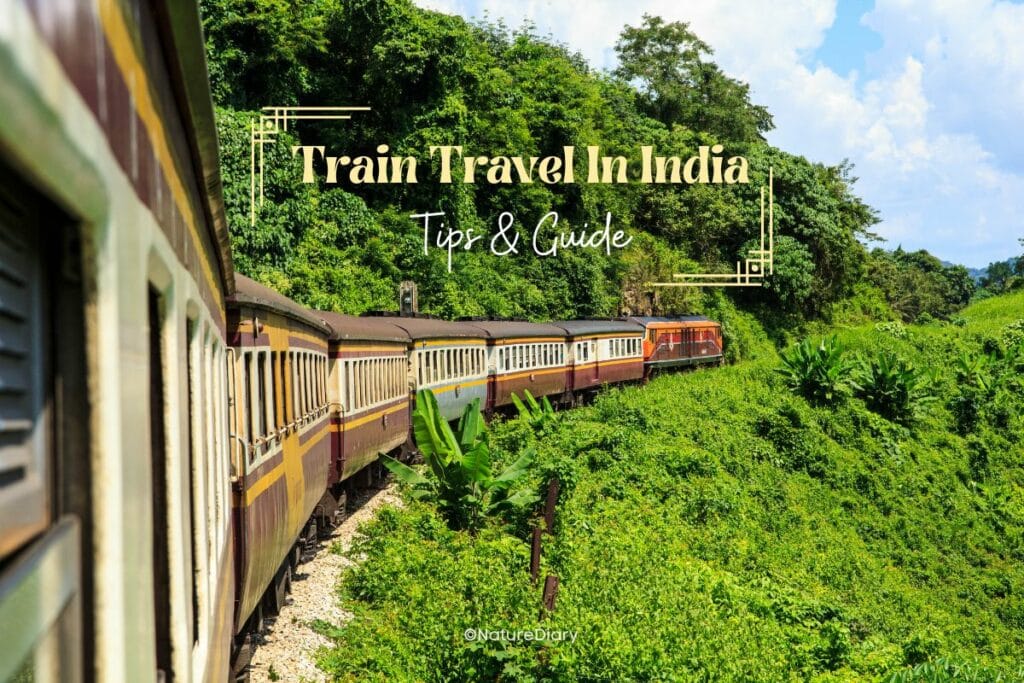
Types Of Trains In India
1. Express Train
An express train is your most reliable option if you’re travelling to a different state. Running at a maximum speed of around 100 Km/hour, these trains are much faster than local and passenger trains. Besides, they also have much fewer stops, which allows them to cover long distances quickly.
Apart from ordinary express trains, Indian Railways has also launched AC Express coaches to offer a more comfortable train travel experience. Special express train routes connecting major cities have been launched too. These are known as intercity express trains, such as the Kolkata – Asansol Intercity Express.
2. Superfast Express Train
Superfast express trains are only slightly faster than regular express trains in terms of maximum speed, which ranges between 100 and 110 Km/hour. However, the former takes even fewer stops, which cuts down on the total travel time.
Superfast trains are also more expensive than ordinary express trains as the fares include a superfast surcharge. The Sampark Kranti Expresses, which connect New Delhi to different state capitals and other important cities, fall into this category.
3. Premium Superfast Express Train
There are a few premium superfast express trains too, which have higher fares and come with additional perks. The Duronto Express and Rajdhani Express, for instance, are long-distance trains in India that runs non-stop from its departure station to its destination.
These trains have sophisticated LHB coaches for a more comfortable and posh travelling experience. These premium superfast express trains get more priority and barely delay for any reason. For long-distance travels, I always prefer Duronto or Rajdhani to reach my destinations on time.
4. Metro Train
Metro railway has become one of the most convenient modes of public transport in metropolitan areas in India. Also known as Rapid train service in some areas, the metro railway frequently uses underground railroads to get across crowded urban areas swiftly.
These trains use completely separate tracks from other trains explicitly designed for them. Metro trains are available every few minutes, and passengers can get on and off at any station along the way. This type of railway offers fast and air-conditioned transit at affordable prices, but it’s available in only 15 Indian cities at the moment.
5. Mountain Train
India also has 7 mountain railways, of which 3 have been recognized by UNESCO as world heritage sites. These are special railway routes running through various mountain ranges. Thanks to the picturesque views one can enjoy during the journey, mountain railways are major tourist attractions.
The Darjeeling Toy train and the Nilgiri Mountain Railway are among the most popular ones, but others, like the Kalka–Shimla Railway, offer unforgettable experiences too. Fortunately, I have travelled on all these three railways and the journeys were pretty exciting!
6. Luxury Train
These trains are operated specifically for tourism purposes rather than regular travel. Complete with various luxurious amenities like minibars, restaurants, spas, fitness cars, etc., these are models of ancient royal trains used by different Indian kings and the British.
Luxury trains pass through different tourist destinations and halt at each of them for excursions. The best trains with luxury facilities in India include the Golden Chariot, Palace on Wheels, Maharaja’s express, etc.
7. Local Train
This is one of the most affordable and popular modes of transport in the country. Also known as suburban or local trains run for short distances – usually between a central business district and the suburban areas surrounding it.
These trains are slower than the rest as they stop at each and every station along the way. Seating is unreserved, and it’s quite common for these trains to get very crowded.
8. Passenger Train
Running at 40 to 80 Km/hour, passenger trains offer a mix of reserved and unreserved seating. These trains stop at almost every station on their routes, although not as frequently as local trains.
There are two types of passenger trains in India – slow passenger and fast passenger trains. Both of them are very economical modes of transport.
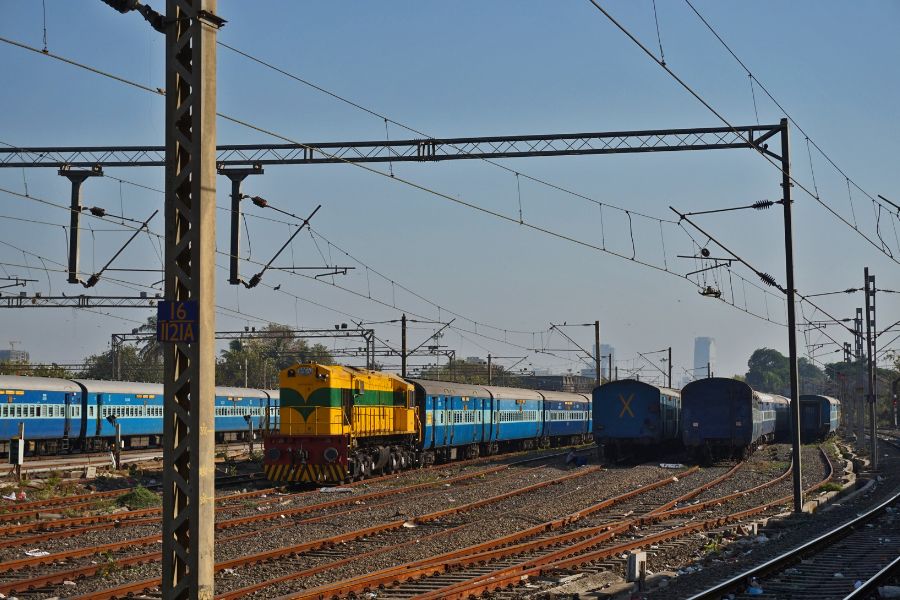
The Classes Of Train
Apart from the different types, one can also choose from various travel classes of trains when booking tickets. This might be a little confusing for those riding the first-time train in India. Your travel experience would depend heavily on the class you’re riding in. Different classes offer varying comfort levels and amenities. Let’s see what Indian Railways offer.
Executive Anubhuti (EA)
These coaches offer a travel experience similar to plane rides. Executive Anubhuti coaches are air-conditioned and come with comfortable recliner seats, infotainment systems, headphones, etc. EA coaches are frequently cleaned and boast very sophisticated sanitation.
Executive AC Chair Car (EC)
Very similar to EA, this is one of the most expensive train classes in India, besides AC First Class. EC coaches also offer a great travel experience, with various amenities, free snacks and drinks, and even large tables in between seats facing each other.
First AC (1A)
These are the most luxurious coaches for long-distance travel, and the tickets can cost around the same as many domestic flights. Travellers can book entire cabins or coupes to themselves and enjoy complete privacy. You can enjoy spacious berths, fresh food prepared in the pantry car, and the added security of lockable doors. First AC coaches also come with shower facilities for the passengers.
First class (FC)
A first-class compartment is very similar to AC first class, minus the air conditioning. If you plan to travel on a first-class train in India, it’s best to go for the First AC class unless you want the privacy of first-class coaches at a lower cost. Otherwise, the third AC is a better choice in terms of both comfort and cost.
Second AC (2A)
The second AC coaches don’t come with individual coupes. They are divided into compartments of three berths each, separated by curtains. These air-conditioned coaches also offer a comfortable travel experience, and the berths are relatively spacious. The fares are somewhere in between 1A and FC class fares.
Third AC (3A)
These coaches offer a mix of affordability and comfort and are an ideal choice for middle-class travellers in India. The coaches are divided into compartments of eight berths each – six regular berths and two side berths. Although 3A coaches don’t offer the privacy and the amenities you’d enjoy in the 2A, FC, or 1A classes, you can easily interact with fellow travellers here.
Third AC economy (3E)
The 3E class was launched to make AC train travel more affordable, but putting more berths per compartment. These coaches have three side berths per compartment rather than two.
Chair Car (CC)
One of the most affordable options for those travelling between different districts or states, chair car coaches don’t have any berths. Instead, they feature chair-style seating. This class is viable for journeys lasting up to a few hours.
Sleeper Class (SL)
Sleeper class is your most budget-friendly option for long-distance train journeys. The berth arrangement is similar to AC 3-tier, with six berths on one side and two on the other per compartment. However, the travelling experience is completely different. Apart from air conditioning, sleeper class coaches also lack the catering services you’d get in 3A class. Instead, you may buy food from vendors boarding these coaches.
Second seating (2S)
Offering the cheapest reserved seating, these coaches come with chair-style seats too. However, the problem with 2S coaches is that they can get quite crowded and congested as they have a mix of reserved and unreserved seats.
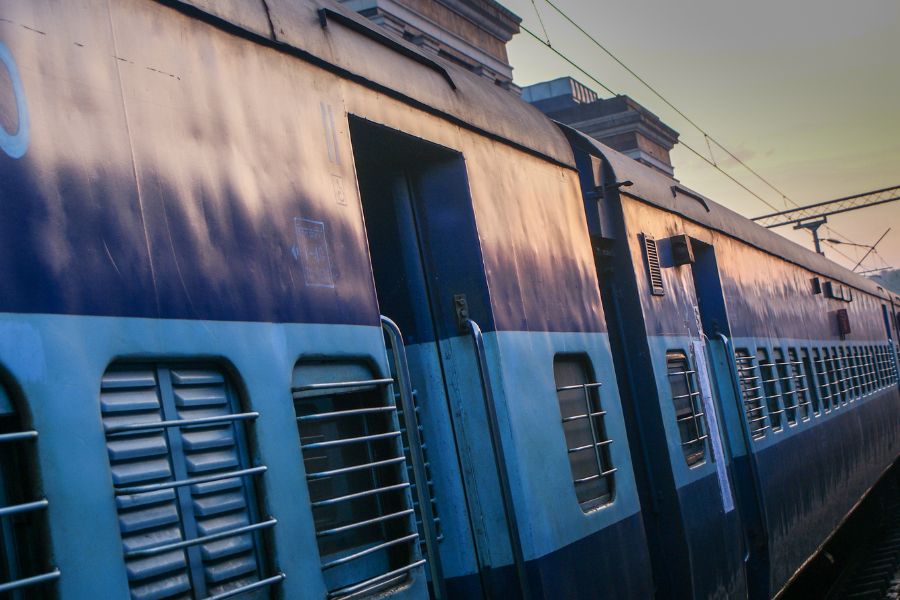
Different Berths On Indian Train
Usually, you have the option to choose your preferred berth when reserving your berths for a train journey. Different berths have their own perks and downsides, which you should always consider while booking your tickets.
- Upper berth (UB): Do note that only the top berths of the face-to-face berths are referred to as upper berths – not the side berths that lie lengthwise. While elderly travellers or women wearing sarees may have a hard time getting up there, an upper berth is perfect if you need to rest.
- Middle berth (MB): Lying between the upper and the lower berth, the middle berth is more accessible. However, it’s not really my most preferred choice as you can neither enjoy the views outside nor engage in conversations very well. Unlike when travelling in the upper berth, you’ll also have to deal with the chatter of people.
- Lower berth: My personal favourite, this berth is next to the window and offers nice views. Lower berth travellers can easily get off their berth without worrying about having to climb back up.
- Side upper berth (SU): Moving on to the side berths, SU refers to the topmost berths among the ones positioned lengthwise along the wall of the coach. This berth offers a couple of nice perks, like extra headspace and allowing you to interact with other passengers with ease.
- Side middle berth (SM): Remember I mentioned that 3E coaches have three side berths in each set instead of two? The side middle berth is the extra berth in question, and it’s one of the worst berths you could get. The cramped space may result in a very uncomfortable travel experience, and you won’t get to enjoy the views very well either.
- Side lower berth (SL): This is the best alternative in case a lower berth isn’t available. Side lower berths offer the same accessibility perks and views as lower berths. You can also chat with your co-passengers with ease. However, people walking past your berth can be a little disturbing due to the position of this berth.
Who Can Ride Trains In India?
Pretty much anyone and everyone can ride trains in India. If you travel by train even a couple of times, you’ll notice people of every age group using it for transport. Even minors and senior citizens wouldn’t have any trouble riding trains. Local trains also have ladies-only coaches to ensure a safe travelling experience for women.
However, you’ll need to choose the travel class and berth according to your requirements and who you’re going with. For couple travellers, the best options are the FC/1A coupes or the side berths in Third AC and sleeper coaches. When booking tickets for family travellers, try to make sure everyone can stay together if possible. For solo travellers, it doesn’t really matter – go for whichever berth you like the most.
If you plan to travel with pets, standard first class and AC first class are your only options. Those are the only coaches where passengers are allowed to carry pets. Alternatively, your dog can travel in the dog box or the brake van.
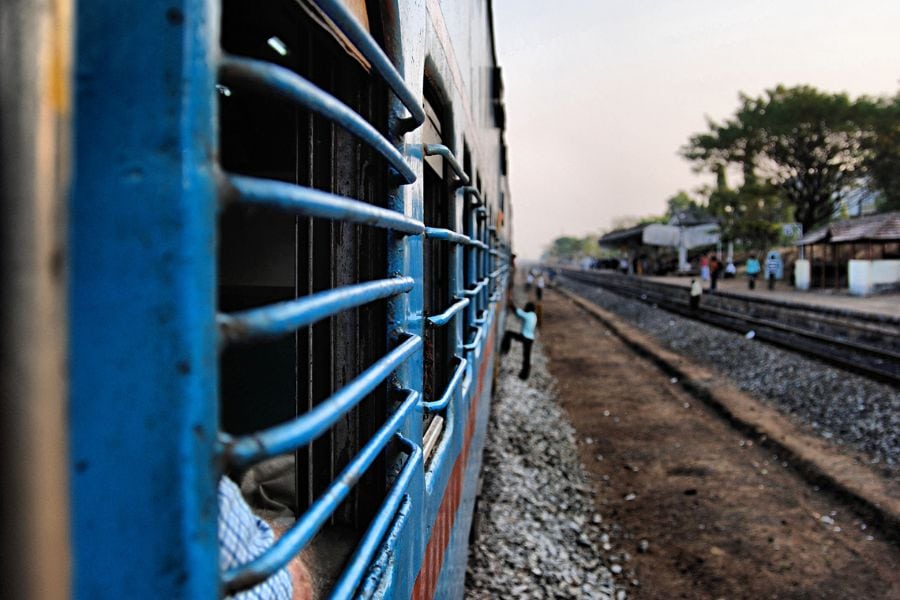
The Fare Of Train Journey
As you know by now, you have plenty of options when booking a train ticket in India and can usually find something that fits your budget. There’s a huge contrast between the fares for AC First Class and sleeper class coaches. This is something you should always keep in mind when booking train tickets.
Here are two charts showing the fare rates for different train classes at varying distances:
1. Fare For Mail/ Express Trains
| Train Class | Minimum distance for charge | Base fare at minimum distance | Reservation fee | Surcharge for superfast trains |
| AC Chair Car | 150 Km | ₹211 | ₹40 | ₹45 |
| Sleeper class | 200 Km | ₹124 | ₹20 | ₹30 |
| Executive class | ₹60 | ₹75 | ||
| Second class | 50 km | ₹30 | ₹15 | ₹15 |
| First class | 100 Km | ₹232 | ₹50 | ₹45 |
| AC First class (Peak period) | 300 Km | ₹1059 | ₹60 | ₹75 |
| AC First Class (Lean Period) | 300 Km | ₹998 | ₹60 | ₹75 |
| AC 2-tier (Peak period) | 300 Km | ₹625 | ₹50 | ₹45 |
| AC 2-tier (Lean period) | 300 Km | ₹605 | ₹50 | ₹45 |
| AC 3-tier | 300 Km | ₹470 | ₹40 | ₹45 |
| AC economy (Duronto) | 300 Km | ₹440 | ₹40 | ₹45 |
2. Fare For Ordinary Trains
| Train Class | Minimum distance for charge | Base fare at minimum distance | Reservation fee |
| Sleeper class | 200 Km | ₹78 | ₹20 |
| First Class | 10 Km | ₹45 | ₹20 |
| Second Class (Suburban) | 10 Km | ₹4 | ₹15 |
| Second class (Non-suburban) | 10 Km | ₹3 | ₹15 |
| First class QST | 10 Km | ₹880 | – |
| First class MST | 10 Km | ₹325 | – |
| Second class QST | 10 Km | ₹270 | – |
| Second class MST | 10 Km | ₹100 | – |
Please note that the above tables contain fares that are subjective to change over the years. We will update it as soon as we get the latest information. You can also visit the official website of Indian Railways.
How To Book A Train Ticket?
You have several ways to book train tickets for your travels. Online booking is obviously the most convenient, but you may also get your tickets at the counter. Here are four ways you can book a train ticket in India.
Online Booking Procedures
1. Using The UTS App for Unreserved Ticket
Indian Railways launched the Unreserved Ticketing Service (UTS) app to make life easier for passengers. Especially in busy urban areas, the queues at ticket counters for local and passenger trains can get quite long. You can instead use the UTS app to book a paperless ticket online.
You first need to download and install the UTS app on your device (Android | IOS). Run the app and register yourself as a new user, signing up with the necessary credentials. Once you have signed up, log in to your account and click on book ticket. Below are the steps to follow for this method.
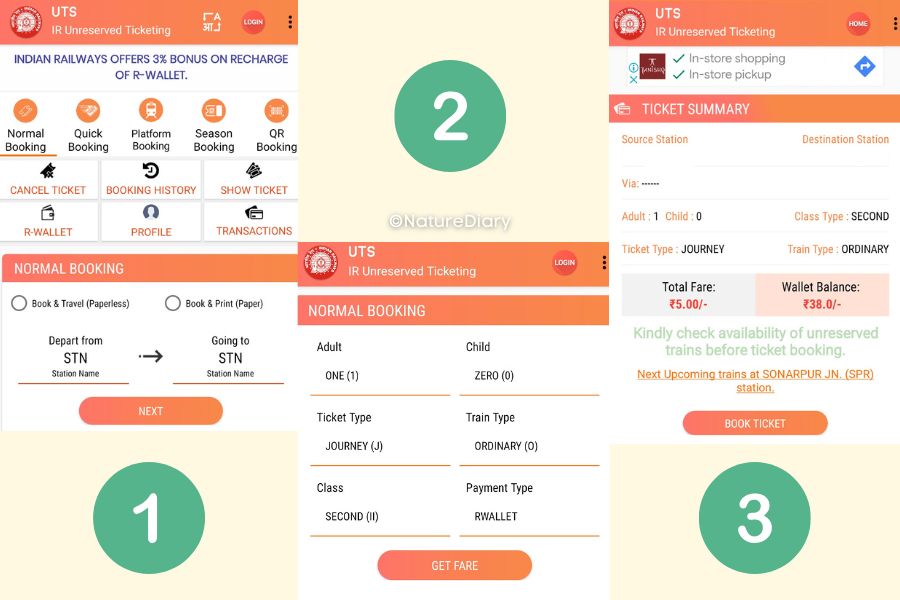
- Step 1: Select ’Normal Booking’ from the options that appear. At this point, the app will ask you to turn on the location/GPS on your smartphone to identify the nearest railway stations. Accept this request. Now you will find two options “Book and Travel (paperless)” and “Book and Print (paper)”. Remember to print the ticket in case you have selected the second option. Then fill up “Depart from STN” and “Going to STN”, and click the NEXT button.
- Step 2: Next you will get 6 boxes on your screen containing the Number of Tickets for Adults and Child, Ticket Type (journey and return), Class, Train Type and Payment Type. Choose the suitable options and click on the GET FARE button.
- Step 3: On the next page, you will find your ticket summery. Verify the details and click on BOOK TICKET button. Do it and complete the payment, and your ticket will be generated.
You may check your tickets later by clicking on the home icon on the top right and tapping on booking history.
2. Booking Reserved Tickets With IRCTC app/ Website
Besides the official train ticket booking website, IRCTC has also launched a mobile app that allows users to carry out various tasks online, such as booking tickets, checking the ticket status, ordering food on the train, etc. Use these steps to reserve seats or berths for long-distance train journeys.
- Step 1: Install the IRCTC Rail Connect app (Android | IOS) and register yourself. Now, log in to your account using the credentials created during registration.
- Step 2: From the homepage, select Plan My Bookings. A page with spaces to enter your departure station, destination, and travel date will appear. Fill them up and click on Search Trains.
- Step 3: The app will now provide you with a list of trains, along with information like their departure time and the availability of seats/berths. Information regarding the availability or non-availability is provided separately for every travel class. You can view the respective ticket prices by clicking on the classes.
- Step 4: Select the train and class of your choice, and tap on passenger details. Now, fill in the details and click on the respective checkboxes to accept the terms and conditions. Keep in mind that each booking can include only up to six adults and two infants maximum.
- Step 5: Once you’ve provided the necessary information and accepted the terms and conditions, tap on Review Journey Details. You can now go over the train information, passenger details, class and berths booked, etc.
- Step 6: If all the details are fine, fill in the Captcha at the bottom and tap on Proceed To Pay. The app offers several payment options – debit card, credit card, net banking, and E-wallets. You’ll find the tickets under your transaction history after completing the payment.
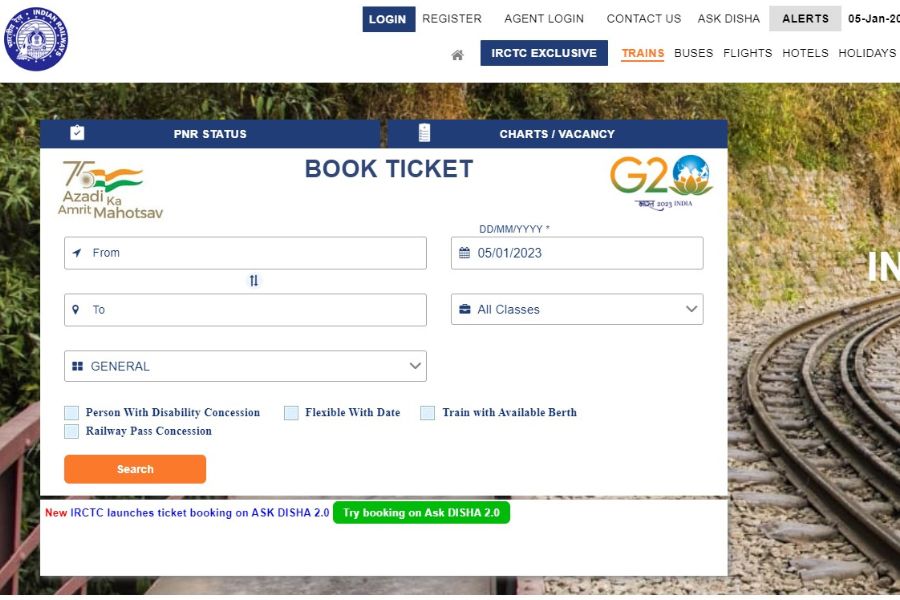
3. Booking Train Tickets With Third-party Apps
Apart from booking directly through the IRCTC app, you can also use various other third-party apps that offer online travel ticket and hotel booking services. Especially if you’re already booking your hotel rooms through an online travel company, it might be more convenient and cost-effective to use it for train ticket booking.
Although they charge an additional service fee that you can avoid by using the IRCTC app, they also offer various discounts, cashbacks, and other special offers.
Every third-party ticket booking app has its own booking procedure and interface. In this regard, you should note that their user interface is usually more intuitive and easier to use than the IRCTC app. This might make them a better choice for users who aren’t too tech-savvy and find the IRCTC app to be too complex.
Examples for such third party ticket booking websites are makemytrip.com, railyatri.in, goibibo.com for domestic travellers and 12go.asia for international travellers.
Offline/ On-counter Ticket Booking
Passengers who find online booking to be too difficult, lack the means to pay online, or face other problems with online ticket booking can get it done offline instead. For this, you need to visit the booking counter at your nearest railway station and request a reservation form.
The form has spaces to fill in with details like passenger information, berth preference, train, train number and name, travel date, etc. Once you have filled it up, submit it at the booking counter along with the payment. They’ll issue your tickets along with your unique PNR number.
Online booking is much more convenient and hassle-free, but sometimes you may not have a choice besides offline booking. You can also get your booking done through brokers and travel agencies, but it’d be much more expensive as they charge extra to earn their profits.
Common Terms Related To Train Ticket
When booking or reading your train ticket, you might come across a number of terms and abbreviations that you’re unfamiliar with. Indian Railways commonly use these terms, and it’s a good idea to learn them beforehand. Below are some of the most common terms related to train tickets.
- PNR: Passenger Number Record
- RAC: Reservation Against Cancellation
- CNF: Confirmed
- CAN: Cancelled
- WL: Waiting list
- RSWL: Roadside station waiting list
- RLWL: Remote Location Waiting List
- GNWL: General Waiting list
- TQWL: Tatkal Quota Waiting list
- PQWL: Pooled Quota Waiting List
- RQWL: Remote Quota Waiting List
- RLGN: Remote Location General waiting list
- LB: Lower Berth
- MB: Middle berth
- UB: Upper berth
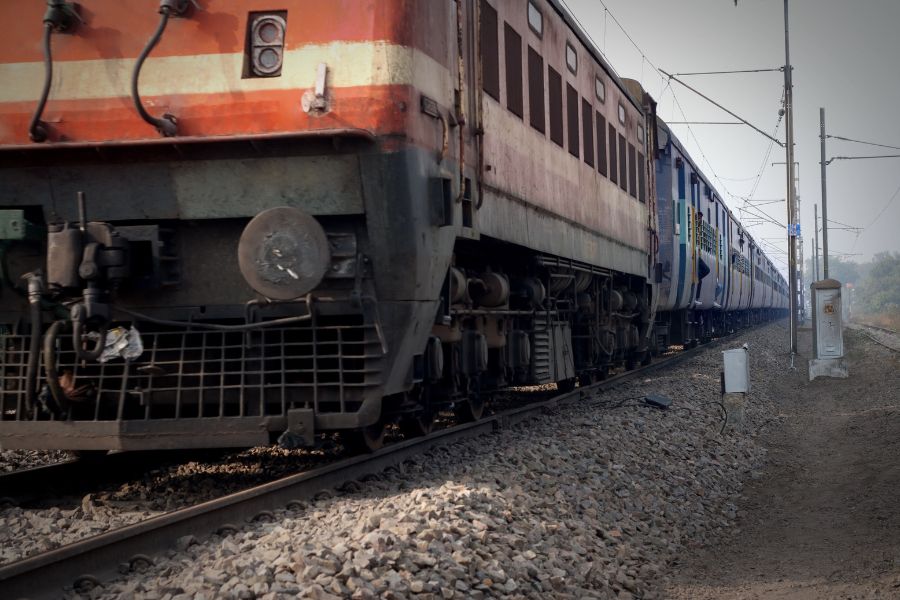
Facilities You Can Get Inside Indian Trains
Indian railways have made significant improvements to train coaches over the years, adding various new facilities. Although not every train class is equally luxurious, some of them can deliver quite an amazing travel experience.
1. Toilet
Most train coaches have toilets, with the exception of local and passenger trains meant for short-distance travel. Usually, there are four toilets per coach – two on each side. During 2021 and 2022, Indian Railways also installed bio-toilets in many trains to reduce the dumping of bacteria on railway tracks.
2. AC and fan
The various air-conditioned travel classes mentioned earlier come with AC units to keep the passengers comfortable during travel. The non-AC coaches have plenty of fans instead to maintain air circulation and comfort. You may also ride a full AC train in India, where all the coaches are air-conditioned.
3. Bed, Pillow And Blanket
Passengers travelling in AC first class, AC Second Class sleeper, and AC 3-tier sleeper receive free bedrolls from Indian Railways. These bedrolls include a pillow, a blanket, two-bed sheets, and a face towel.
Hence, you don’t have to worry about it getting too chilly at night in air-conditioned coaches. In case you don’t receive your bedrolls for any reason, you’re entitled to a refund of ₹20 once you reach the destination station. You’ll need a certificate from the TTE as proof of your claim.
4. Dustbin
As of now, Indian Railways has fitted only the air-conditioned coaches with dustbins as these coaches have sealed windows, and passengers end up littering the coaches. They’ve also integrated some of the modern trains like Tejas Express with sophisticated compacter dustbins that crush garbage to make more space inside.
5. Charging Point
Most sleeper train coaches have charging ports beside the seats or berths. You need not worry about not being able to charge your phone during long train journeys, regardless of the class you’re travelling in (unless others are using them already).
6. Reading Lamp
Travelling in the AC 2-tier sleeper class will also get an individual reading lamp in your berth. This is quite useful if you don’t want to go to sleep and night and have work to do.
7. Luggage Security
The cabins and coupes in first-class coaches (both AC and non-AC) have doors that you can lock. This ensures significant luggage security, as you need not worry about your stuff getting stolen as you sleep.
However, this feature isn’t available in other travel classes. You’re allowed to carry luggage in the luggage van for free up to a certain weight limit, over which you’ll have to pay an extra fee. It is pretty secure, although there’s a chance that your stuff may get damaged unless packed very well.
8. Child Safety
Northern Railway has recently taken up the initiative and launched special baby berths as an experiment. Currently available only on certain trains, these berths have baby-sized foldable extensions on the outer edge. The extended berth area has a railing to prevent babies from falling off and straps to keep them secure.
9. Food Items
Long-distance trains have pantry cars to prepare fresh food on the move. However, this is only for only passengers travelling in first class and AC first class coaches. Those travelling in AC 2-tier and AC 3-tier receive food prepared at IRCTC’s kitchen facilities at various stations along the way. Indian Railways has also launched an eCatering service, through which passengers can order restaurant food while travelling in trains.
Food On Indian Trains
Let’s dive a bit deeper into the availability of food on trains in India and see how you can while travelling:
1. Pantry Cars
As mentioned earlier, long-distance trains have pantry cars. Apart from catering to the 1A and FC passengers with food cooked on the train, the pantry car personnel also take down orders from those travelling in 2A, 3A and sleeper coaches. They pass on the orders to a station on the way with kitchen facilities, where they collect the food and load them onto the train.
2. Online Order
You can now use the IRCTC app to order food online too. The eCatering service is a great initiative by IRCTC that allows passengers to enjoy restaurant food while travelling by train. They have partnered with various FSSAI-approved restaurants at more than 450 stations. Placing the order is easy too, since your details and other information are already linked to your PNR number.
3. Buy At Train Stations
You always have the option to buy food at railway stations along the way, provided that the train will stop there long enough. Note the halt times and be careful not to get stranded because your train took off while you were buying food.
A variety of foods are available at railway stations, although snacks are the most common. When travelling in sleeper class or chair cars, you may also buy food from vendors boarding the train at different stations.
4. Pre-packed Food
If you aren’t travelling in a coach with catering facilities and don’t want to take your chances with buying food during the journey, you can carry long-lasting pre-packaged food. This is also a good solution for those who prefer homemade food due to health concerns. Choosing relatively dry food items is advisable, so you don’t have to worry about leaks or creating a mess. Also, make sure the food won’t go bad by the time you can eat it.
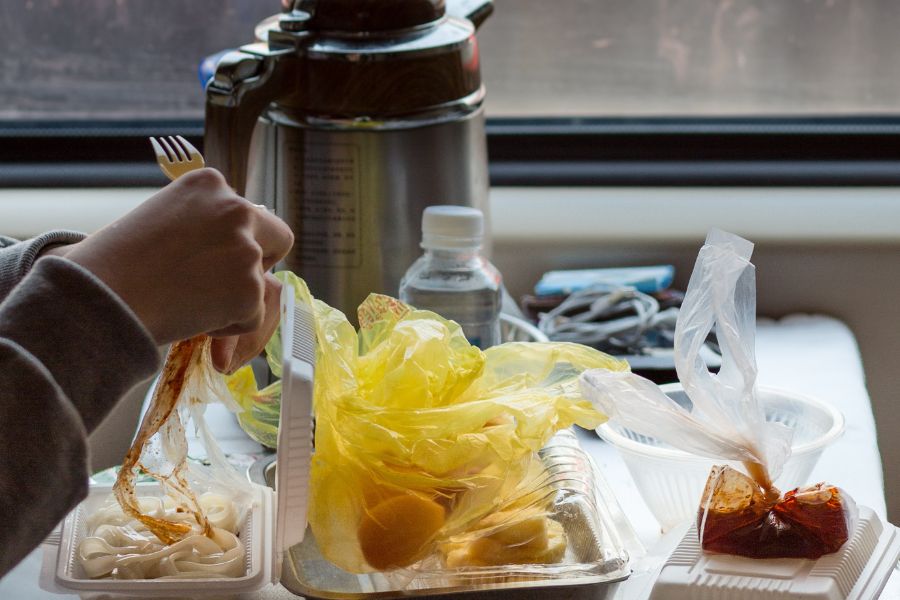
Things To Carry While Travelling on Trains
For individuals unfamiliar with travelling by train, packing for the journey might appear to be a daunting task. While you can’t afford to leave behind anything important, carrying extra and unnecessary luggage isn’t recommended either. Here are six things that you should carry when travelling by train in India:
1. Ticket And Other Essential Documents
Forgetting your tickets at home is a terrible idea. Travel ticket examiners (TTEs) board reserved compartments to ensure no one is travelling without tickets and everybody is in their assigned seats. You must display your ticket and prove that you have booked one to avoid getting in trouble.
Thankfully, you don’t necessarily need a physical copy of the ticket – a PDF version of it on your smartphone will do just fine. Hence, in case you book your train tickets online, you don’t need to print them out.
Apart from your tickets, you should always carry proof of identity while travelling. Your Aadhar card is an ideal choice for this, although a voter ID card or driving license would work too.
2. Your Mobile Charger
Unless you’re travelling for a day and are confident your phone has enough battery life, you should always carry your mobile charger. You can charge it on the go using the charging point beside your seat. Also, definitely carry a power bank if you have one, just in case the charging point is faulty.
3. Water Bottle
Even if the journey isn’t long enough for you to need meals on the way, you’ll need water. You can easily buy a bottle of packaged drinking water at a station or from vendors boarding the train. However, carrying your own water bottle from home is advisable to save money and reduce waste. This is even more important when travelling to desolate places where you might not find shops or vendors to buy water from.
4. Safety Locks
Luggage safety is a huge concern on Indian trains, as anybody can board or get off a train at any given time, even without tickets. Unless you’re travelling 1st class, there are absolutely no luggage security features to protect your stuff from theft.
You should always use safety locks to secure your luggage bags while travelling, regardless of your mode of transport. Travel trolley bags are the best options for train travel as they are easy to carry and have locking facilities. Besides this, it’s advisable to carry a chain with a lock to tie your bags to your seat during train journeys too.
5. Earphones
A pair of earphones can prove to be invaluable during long train journeys when it’s easy to get bored unless you’re travelling with a group of friends.
Apart from these essential items, you may like to carry a neck pillow, travel clothing, hand sanitiser, toilet seat sanitiser, soap paper, biodegradable wet wipes, sleeping bag liner, inflatable travel pillow, power bank and books. You may also like to check the list of travel essentials worth carrying on your trip.
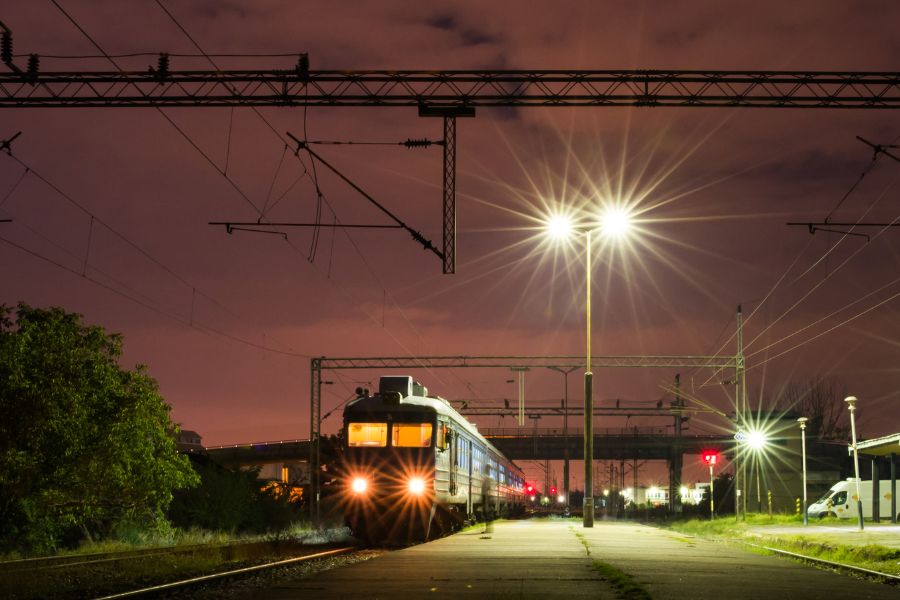
Tips For Travelling By Train In India
It can take you some time to get accustomed to train travel in India. Especially if you’re travelling in sleeper class or one of the other coaches without a lot of amenities, it might initially be a rough experience. To help you avoid potential hassles and enjoy a smooth journey, I’m going to share a few tips I learnt from my own experiences.
1. Pack Some Extra Food
Due to unexpected delays, train journeys can take much longer than they’re supposed to. In worse cases, the train might stop for a long time in the middle of nowhere. When embarking on a long train journey, it’s always wise to pack some extra food for such situations.
It doesn’t necessarily have to be a meal – simple dry snacks like nuts and biscuits are fine too. You just need something to keep you from starving until you can find a meal.
2. Book Your Tickets Well In Advance
In a country as densely populated as India, it’s only normal for train tickets to be very high in demand. Unless you book your tickets ahead of time, you might end up on the waitlist or not even get a ticket at all.
Train tickets are available for booking 60 days before the date of departure, and it’s best to get yours as soon as possible. This is especially true if you plan to travel during certain times of the year, such as the winter months, Diwali, and during other major festivals.
3. Look For Nearby Stations If Tickets Aren’t Available
Considering the high demand for train tickets to major cities and popular tourist destinations, it’s quite common to find no tickets available on your preferred travel date. In such cases, check if you can get tickets to other stations near your destination station. Although it’s a bit inconvenient compared to a direct train route, you can get a cab or an auto rickshaw to cover the remaining distance.
4. Travel At Night
For long train journeys, it’s best to opt for nighttime travel if possible. It’s easier to spend your time sleeping, and you don’t have to spend in a hotel room for the night. Besides, there’s far less noise and commotion at night since most passengers are asleep, ensuring a more relaxing journey.
Travelling at night also means you don’t waste a day travelling to your destination. You can check in at the hotel early and spend the whole day sightseeing.
5. Always Carry Toilet Supplies
Unless you’re travelling in one of the costlier classes, dirty bathrooms will always be a problem on Indian trains. Running water is also limited, which can cause severe inconvenience during long journeys. As mentioned earlier, you should always carry hand sanitiser and some toilet paper during long train journeys.
6. Reach The Station Early
When you have a train to catch, never aim to reach the station with just a few minutes at hand. In case you are unaware, major railway stations in India are huge, with 10 or more platforms in many cases.
It might take you far longer than expected to get to the platform where your train will be arriving. Add up the time taken to navigate through the crowds and the heaps of luggage, and you’ll see why it’s wise to reach the station at least half an hour in advance.
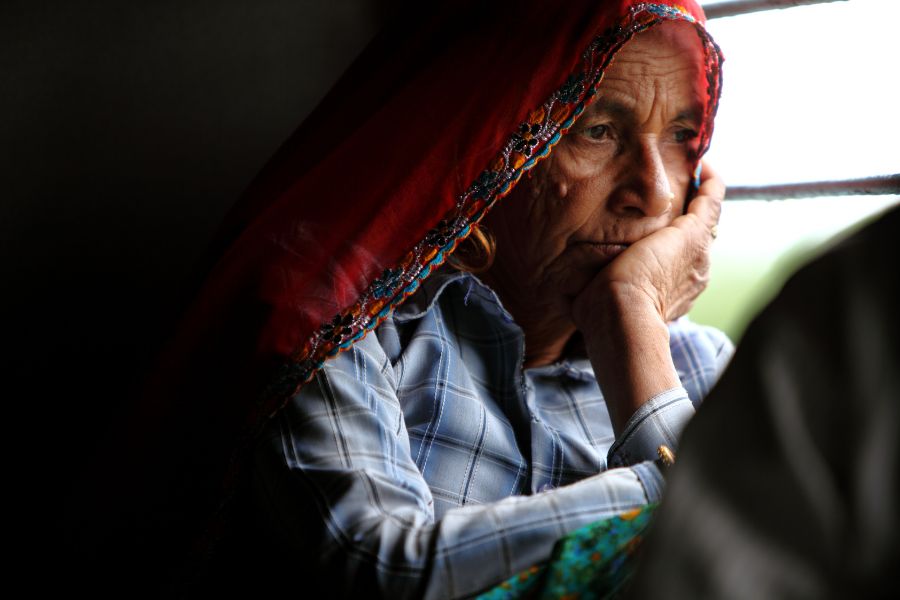
Frequently Asked Questions (FAQ)
Unless your waitlisted ticket is confirmed, you’re not allowed to board the train. Only when people with confirmed tickets cancel their bookings the waitlisted tickets are promoted to confirmed status in serial order. Unconfirmed waiting list tickets are refunded by Indian Railways. Travelling with unconfirmed waiting list tickets is illegal.
Reserved compartment tickets are specific to the respective trains. You can only board the train for which you’ve booked the ticket. However, this doesn’t apply to unreserved tickets like those for local trains or general coaches in other trains, and you’re free to board a general bogie on a different train.
Every train reservation has a PNR number linked to the passenger details. If you book a train ticket in your name, only you’re allowed travel on it. However, IRCTC now allows passengers to transfer train tickets to someone else. You’ll have to visit the reservation counter with your ticket and ID proof of the person to whom you wish to transfer the ticket.
You can board your booked train at a different railway station along the way, and there shouldn’t be much of a problem if it’s just 2-3 stations away from the boarding station on your ticket. However, in case you board it from one of the previous stations, you may have to pay the penalty for the extra distance. You can also change your boarding station on the IRCTC app in advance, which is a much safer option.
It’s recommended to book your train ticket as early as possible. This not only increases the likelihood of getting confirmed tickets but also allows you to choose the berths as per your preference. Train tickets are available for booking up to 60 days in advance, excluding the departure date.
There are various apps that would enable passengers to locate and track their trains live on the map while travelling. I use the app Where is My Train on my own trips, which is one of the most popular apps. Developed by Google for Indian Railways, this app provides various information such as the live location, train speed, schedules, etc.
Train travel in India might initially seem complicated, but it’s one of the most convenient modes of travel once you get used to it. Booking train tickets online is easy, and so is managing your booking and checking your ticket status.
I’ve always preferred travelling by train, and the digitalisation of the services through the IRCTC app has made things even better. In case you weren’t sure how to travel by a first-class sleeper train in India, I hope this guide has cleared up your doubts.
I hope you’ll enjoy a great train journey and gain an experience worth remembering.